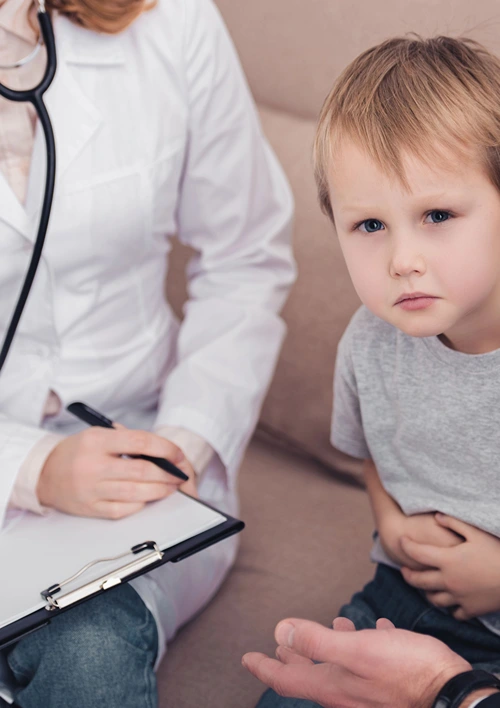Tummy Troubles In Kids: 7 Symptoms You Shouldn’t Ignore
It’s common for kids to complain about stomach pain. It often goes away in an hour or less and isn’t anything to worry about. But sometimes, the pain lasts longer or comes with other symptoms that can be worrying. Young children often have a hard time explaining how they feel.
This can make it tough for parents like you to know what’s really going on. Therefore, it can be hard to tell whether it’s just a simple discomfort or a sign of something serious. This guide outlines the telltale signs you shouldn’t ignore when your child has a tummy ache.
1. Severe Abdominal Pain
Kids can get stomach aches for various reasons, such as gas, constipation, or simple nervousness. And you often expect it’s nothing serious. However, you should think twice if the pain doesn’t subside in a few hours.
You can tell it’s alarming if your child doubles over or cries uncontrollably. They probably can’t bear the pain much longer. This kind of discomfort requires urgent care to find out what’s causing it.
If that sharp, intense sensation begins near the belly button and then shifts to the lower right side of the abdomen, it may suggest appendicitis.
To get an accurate diagnosis, it’s best to consult a pediatric gastroenterology specialist. They’ll perform necessary tests, rule out any underlying conditions, and recommend the right medication and treatment plan.
2. Unusual Stool Color
It’s unusual for stools to have blood or appear black and tar-like. However, there are a few things to consider before jumping to conclusions. Certain foods and medications, like iron supplements, can change stool color without causing concern. Simply put, it might be a harmless side effect. Hence, it’s still important to keep an eye on it to be sure.
Bright red blood may come from the lower part of the digestive tract. Sometimes, it appears as tiny flecks or streaks mixed throughout. This might indicate conditions such as anal fissures, hemorrhoids, or Inflammatory bowel disease.
Meanwhile, dark, tarry, or black stools (melena) suggest bleeding higher up in the digestive system. This type of bleeding can result from ulcers or other serious conditions. It shouldn’t be ignored if it happens more than once or is accompanied by symptoms like belly fatigue.
3. Noticeable Signs of Dehydration
Medical studies have shown that children are more susceptible to dehydration than adults. Their smaller bodies lose fluids more quickly, especially when dealing with stomach-related illnesses like diarrhea or stomach flu.
When a tummy ache comes with frequent trips to the bathroom, there’s a risk your kid isn’t keeping enough fluids in. Mild dehydration can be hard to catch at first. You might notice your kid has a dry mouth, cracked lips, or is peeing less often. Others may seem more tired than usual or a bit cranky. Your home remedy would be oral rehydration solutions to replace lost electrolytes.
As it worsens, other symptoms may show up, such as no tears when crying, dark urine, or sunken eyes. There are signs that need close monitoring.
4. Swollen Abdomen
After a big meal, it’s normal for a child’s stomach to feel a little tight or puffy for a short time. A bloated belly settles on its own, usually within a few hours, as digestion progresses.
But if you notice that your child’s stomach looks swollen as the time goes by, that’s not normal at all. A belly that stays firm or looks larger than usual might point to an issue beyond a full tummy.
Ongoing swelling could be linked to food intolerance, indigestion, or gastric problems. And it’s more alarming if it comes with severe pain, a change in appetite, and fewer bowel movements.
5. Persistent Vomiting
Occasional vomiting happens to children, especially during stomach bugs that circulate schools and daycares. These short episodes usually clear up within 24 hours and respond well to home care measures like rest and fluids.
But if it doesn’t go away after a while, it can be worrying. It can lead to dehydration, particularly in toddlers with lower fluid reserves. Children who can’t keep liquids down for several hours need immediate medical care. You can also check if there’s any green or bloody vomit, as these always warrant an emergency room visit. These colors might indicate a blockage in the digestive tract.
6. Pain During Urination
Tummy aches sometimes go hand-in-hand with urinary issues. If your child says it hurts to pee, needs to go more often than usual, or has trouble holding it in, they might have a urinary tract infection (UTI). Some kids with UTIs also complain of lower belly pain, particularly around the bladder area.

Other symptoms to look for include fever, cloudy or foul-smelling urine, and wetting accidents. If any of these occur along with abdominal discomfort, it’s a good idea to have your child’s urine tested.
UTIs are common and usually easy to treat with antibiotics. However, leaving them untreated may lead to more severe kidney problems.
7. Difficulty Swallowing
You may wonder what this symptom has to do with tummy troubles. Difficult swallowing, also known as dysphagia, can sometimes signal a problem in the gastrointestinal (GI) tract. If your child struggles to eat, gags frequently, or says it feels like something is stuck in their throat, it’s vital not to brush it off.
In some cases, this could be related to gastroesophageal reflux disease (GERD) or acid reflux or GERD. Stomach acid irritates the throat and makes swallowing painful. It might also stem from inflammation or swelling or inflammation in the esophagus.
Key Takeaway
Children often get tummy troubles, and most of the time, it’s nothing to stress about. Of course, as a parent, you know your child best. It’s also natural to feel anxious when they’re sick. If something isn’t right or when in doubt, don’t hesitate to check in with your pediatrician.
Being aware of these warning signs can help catch potential health concerns early and give you peace of mind. After all, it’s always better to ask the experts and be reassured than to wait and worry.




